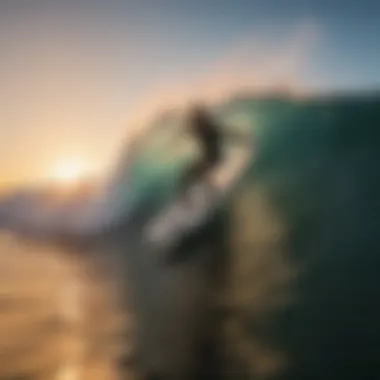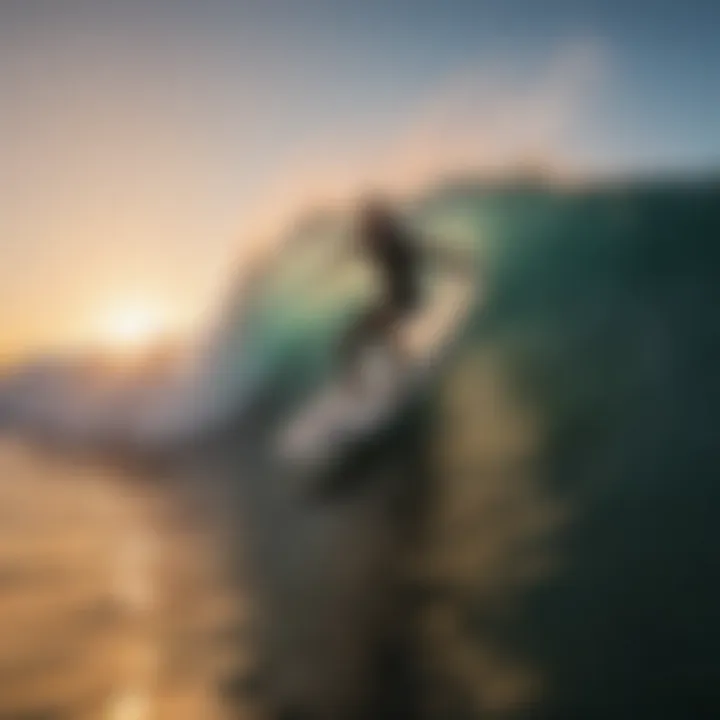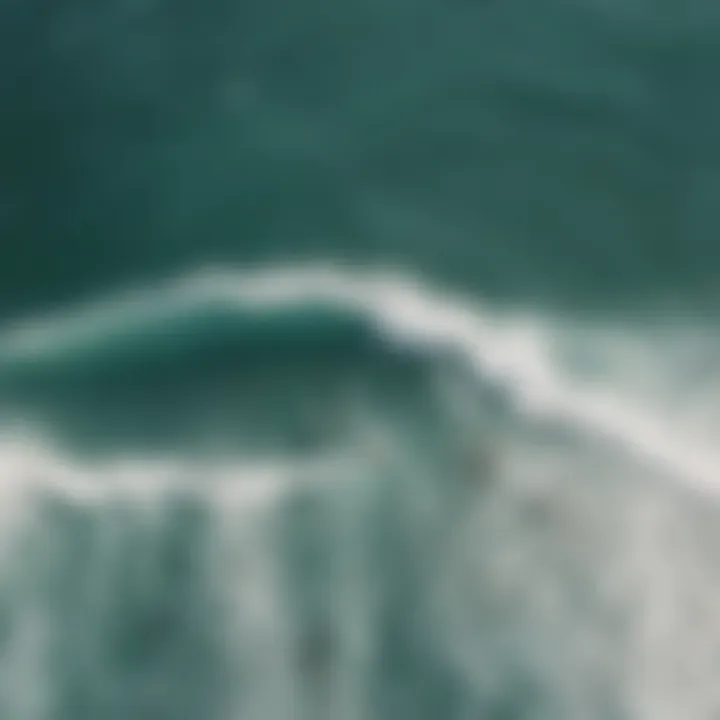Discovering Watersports: The Essence of Surfing


Intro
Watersports have been a cornerstone of human recreation for centuries, bringing joy and excitement to those who seek interaction with the vastness of oceans, lakes, and rivers. Among these activities, surfing stands out not just as a sport but a cultural phenomenon. Many people don’t realize that the art of riding waves is steeped in history and tradition, evolving through diverse forms and styles across different continents. It’s more than just paddling out; it encompasses a lifestyle that encourages a deep connection with nature.
As we embark on this exploration of watersports, particularly surfing, it’s essential to understand the fundamental techniques that serve as the backbone of this exhilarating activity. From mastering the basic paddling stroke to eventually catching that awe-inspiring wave, each step is pivotal in transforming an enthusiast into a competent surfer. Moreover, with the advent of technology and innovations in gear, new surfers can harness tools that amplify their experience while promoting safety.
This article aims to bridge the gap for both novices eager to learn and seasoned surfers looking to refine their skills through structured insights on historical context, required techniques, necessary gear, safety practices, and environmental stewardship. Through this guide, not only will you gain practical knowledge, but you may also deepen your appreciation for the ocean and the intricate dance of riding waves.
Techniques and Skills
Surfing is as much about technique as it is about passion. To ride waves with confidence, one must develop a range of skills. Whether you are a beginner just dipping your toes into the surf culture or an experienced wave-rider, a focus on these techniques is crucial.
Essential Techniques for Beginners
For those just starting, the initial hurdle is often the most daunting: getting comfortable on the board. Here are some key strategies:
- Paddling: This is the most fundamental technique. Start by lying on your board with your body centered. Use your arms to paddle, ensuring you’re smoothly cutting through the water.
- Positioning: Understanding where to sit on the board affects your speed and stability. Find that sweet spot where you’re not too far back or too far forward.
- Pop-Up: This move transforms you from lying down into a standing position. Practice popping up quickly while maintaining balance, ideally within the first few waves.
- Reading Waves: Learn to identify the right kind of waves to catch. Observe the ocean’s movements and be patient; sometimes the best waves come to those who wait.
Advanced Skills for Experienced Watersport Enthusiasts
As surfers progress, they often delve into more technical maneuvers that enhance their surfing experience:
- Carving Turns: Mastering turns will allow you to navigate waves intuitively. Practice shifting your weight from your toes to your heels.
- Cutbacks: This technique can keep you in the surf and create a thrilling ride. Carve back towards the white water to regain speed.
- Aerial Moves: For some, aerial tricks are where the artistry of surfing shines. Testing these requires confidence and good timing.
- Environmental Awareness: Advanced surfers often have a strong connection to their surroundings; understanding ocean currents, tides, and weather patterns is essential.
"Surfing is not just a sport; it teaches you to ride the ups and downs of life while respecting nature's beauty."
By honing these techniques and skills, surfers not only develop a supportive community but also foster a deeper understanding of this dynamic sport.
Equipment and Gear
No discussion of surfing would be complete without a thorough examination of the gear that supports these techniques. Having the right equipment can make all the difference, whether you’re just starting or pushing the limits in a more advanced realm.
Must-Have Gear for Each Watersport
When it comes to watersports like surfing, certain equipment is non-negotiable:
- Surfboard: The selection varies based on skill level and wave types. Beginners often benefit from longer, wider boards offering greater stability.
- Wetsuit or Rash Guard: Depending on the local climate, proper thermal protection is key for comfort and warmth.
- Leash: This essential accessory prevents your board from getting lost in the waves and keeps you safe.
- Wax: Applied to the board for grip, wax helps maintain footing when riding waves.
Tips for Selecting the Right Equipment
When choosing appropriate gear, it’s vital to consider various factors:
- Skill Level: Beginners should prioritize stability, whereas seasoned surfers might look for performance.
- Local Conditions: Characteristics of the surf spot, such as wave height and water temperature, can dictate your choices.
- Rent before you buy: Trying different boards can help identify what feels best for you.
When embarking on this journey of exploration into the world of watersports, being well-equipped and knowledgeable about techniques fosters both safety and enjoyment. As you conquer the waves, remember to respect the ocean and its possibilities.
Preface to Watersports
Watersports capture the true essence of freedom, allowing people to connect with nature, test their limits, and experience the thrill of riding waves, gliding across lakes, or exploring rivers. This article zeroes in on the exhilarating world of surfing, a discipline that embodies both excitement and challenges. Understanding the significance of watersports comes with appreciating their varied attributes. Not only do they provide physical benefits, but they also bolster mental resilience and offer a unique way to bond with others, be it friends or a thriving community of fellow surfers.
In recent years, there has been an increased interest in watersports, notably due to the push for healthier lifestyles and the growing awareness of marine environments. The remarkable aspects of this domain draw adventure seekers, exercise enthusiasts, and individuals looking to escape daily routines. Moreover, safeguarding aquatic ecosystems has become integral in these sports, fostering greater appreciation for the natural wonders below the surface.
Defining Watersports
To put it plainly, watersports encompass a wide array of activities that take place on or in water bodies, whether they be fresh or saltwater. Generally, these actions can fall under two broad categories: recreational and competitive. Each of these categories may include various disciplines like swimming, kayaking, wakeboarding, and of course, surfing.
Surfers often relish the wonderful contrast between serene waters and powerful waves. The act of riding waves transforms what could be a leisurely dip into an adrenaline-filled experience that melds excitement and grace. Every surfer finds their own joy in dealing with nature's unpredictable rhythms, making it a sport steeped in both personal exploration and communal ties.
The Rise of Surfing


Surfing has exploded onto the global scene, morphing from a local tradition in Hawaii to a cultural icon recognized worldwide. Historically, surfing traces back over a thousand years, initially practiced by Polynesian nobility and later embraced by the broader community. It signified more than mere sport; it represented harmony with the ocean, craftsmanship in wave riding, and a lifestyle.
Today, surfing’s growth can be attributed to films, social media, and global competitions like the World Surf League. These platforms’ve helped surf culture reach every corner of the globe, inspiring countless individuals to throw on a wetsuit and hit the waves.
Much more than just a physical endeavor, surfing blends artistry with athleticism. Surfers conduct an ongoing dance with nature, testing their skills against the sea's waves and currents. The rhythmic pull of the ocean lures many to become lifelong enthusiasts, which calls to mind the perfectly fitting quote:
"Surfing is not just a sport, it's a passion that runs deep like the waves themselves."
It is this very passion that nurtures friendships and encourages the spirit of competition, making the surfing community a unique tapestry of diverse individuals united by their love for the ocean. As we explore more nuanced aspects of surfing, it becomes clear that this journey is as much about discovery as it is about action.
The Art of Surfing
Surfing is not merely a sport; it’s an intricate dance with the ocean’s rhythms. The importance of understanding the art of surfing is paramount for anyone who wishes to thrive in this captivating world. It goes beyond just riding the waves; it encompasses a deep connection with the water, recognizing how to interact with the sea, and mastering specific techniques that define successful surf culture. One cannot truly appreciate surfing without investing the time to learn its craft.
Understanding Surfing Techniques
Basic Stances
The foundation of surfing lies in mastering the basic stances. The way a surfer positions themselves on the board greatly influences their ride. The primary stance is typically either regular, where the left foot is forward, or goofy, where the right foot leads. What’s crucial to note is how this initial positioning affects balance and control on the waves. Choosing the right stance is beneficial because it allows for better wave catching and maneuverability. A surfer who is confident in their stance will find it easier to adapt to different wave conditions. However, one potential disadvantage is that beginners might struggle to determine their dominant foot, leading to confusion early on.
Catch and Ride
Catch and ride is another essential aspect of surfing. This technique focuses on how a surfer effectively paddles into a wave and transitions onto the board. The ability to timing your movements with the wave’s rhythm is what sets proficient surfers apart. The key characteristic of catching a wave well lies in the surfer’s capacity to read wave conditions. Knowing when to paddle hard and how to position the board can mean the difference between a thrilling ride and a wipeout. This skill is particularly advantageous for beginners as it fosters instant gratification and builds confidence on the water. However, improper techniques can result in missed waves, which can be disheartening.
Turning and Maneuvering
Turning and maneuvering are crucial for controlling the surfboard once you've caught a wave. Surfers use specific weight shifts and foot placements to direct their board in the desired direction. This technique helps keep the ride dynamic and responsive to the wave's movements, allowing surfers to showcase their style. The benefit of mastering turning lies in the ability to navigate through various wave types. A distinguishing feature here is the adjustment of body weight; shifting just a little can change the trajectory dramatically. On the flip side, beginners may find this transition challenging, leading to loss of balance and potential falls.
Types of Surfboards
Shortboards
Shortboards are slim and designed for high performance. They cater to surfers who seek agility and speed, especially in larger waves. Characteristically, their shorter length allows for sharper turns and quick movements. This aspect makes them a popular choice among experienced surfers who enjoy the adrenaline rush of surfing bigger swells. However, they require a certain level of skill to ride effectively, which may not be suitable for beginners still mastering the basics.
Longboards
Longboards offer a stark contrast to shortboards. With their increased length and wider shape, they provide stability, making them ideal for beginners. The key characteristic here is their ability to catch smaller, slower waves which is perfect for surf newbies. An additional benefit is the ease of paddling, allowing surfers to conserve energy while learning technique. However, the trade-off is their less maneuverable nature, which might disappoint advanced surfers looking for rapid turns and tricks.
Funboards
Funboards serve as a bridge between shortboards and longboards. They are versatile, boasting characteristics from both styles. With mid-range length, funboards cater to a wider audience, fitting both novice and experienced surfers. A unique feature is their balance of speed and stability, enabling surfers to experiment with techniques without sacrificing control. One downside could be that serious surfers may find them lacking in performance compared to specialized boards, but they are great for casual, enjoyable sessions.
"The ocean is a teacher; it shows you the beauty in falling and the thrill of rising again."
In summary, understanding the art of surfing is an essential step in embracing this thrilling activity. By mastering surfing techniques, trying different board types, and developing personal style, surfers open doors to a richer surfing experience.
Surfing Culture and Community
Surfing goes beyond just a sport; it's a way of life, deeply intertwined with the culture and community that thrives around it. Understanding this aspect is crucial, as it influences how surfers interact with the ocean, each other, and the environment. The communal dynamics foster a sense of belonging, highlighting both the challenges and the joys that come with being a part of the surfing world.
The culture emphasizes camaraderie, respect, and the shared love for the waves, yet it also introduces its own set of complexities, from localism to the empowerment of underrepresented groups, such as women in the sport.
The Surf Community
Localism and Traveling Surfers
Localism often plays a significant role in surf culture, where established surfers claim ownership over specific surf breaks. This aspect can create an unspoken hierarchy, with locals sometimes viewing traveling surfers as intruders. However, this characteristic of localism contributes significantly to the overall feeling of community. Surf spots develop their unique identities, heavily influenced by those who frequent them.
Key Characteristics of Localism:
- Territorial Behavior: Locals may exhibit protective behaviors over their surf spots, leading to both positive and negative interactions.
- Community Identity: Localism contributes to a sense of identity and pride within the surfing community. When locals uphold their traditions and unwritten rules, they help maintain the integrity of the spot.


While localism can deter outsiders, it can also encourage a more respectful surfing experience. For example, traveling surfers who take the time to learn and respect the local customs often enjoy richer interactions and shared knowledge with the surf community. However, it is essential to navigate these waters delicately to avoid tensions that could bubble to the surface.
Women in Surfing
The burgeoning participation of women in surfing has profoundly transformed the landscape of the sport. Historically male-dominated, the realm of surfing has seen women rising to prominence, both in competitive scenes and within the local communities. Their contributions go beyond just performance; they are critical in reshaping perceptions and pushing for inclusivity in the culture.
Key Characteristics of Women in Surfing:
- Role Models: Female surfers often become role models, challenging stereotypes and motivating young girls to take up the sport.
- Empowerment and Community Building: Many women-centric groups and events, like SheSurf and SurfSistas, foster supportive environments, encouraging more participation and collaboration.
The unique aspect of women in surfing is how they infuse creativity and diversity into wave riding. They promote sustainable practices and often advocate for environmental issues, emphasizing the interconnectedness of surf, community, and nature. Yet, while progress has been made, challenges remain, especially in achieving equitable representation and opportunities in mainstream surfing.
Competitive Surfing
Competitive surfing adds yet another layer to the surfing culture, driving surfers to enhance their skills and push boundaries. Events like the World Surf League showcase not only talent but also the passion that drives surfers worldwide to pursue excellence. Competitive surfing attracts audiences and facilitates community engagement, making it a vital aspect of the surfing culture.
Key Characteristics of Competitive Surfing:
- Showcasing Talent: Competitions highlight distinct styles and techniques, offering young surfers role models to aspire to.
- Community Pride: Local surfers competing on prominent stages generate pride and investment from the local communities, often bringing surges of support and camaraderie.
The unique feature of competitive surfing is the mixture of personal and collective achievements. While it celebrates individual talent, it also strengthens community bonds as locals rally behind their representatives. However, the pressure and commercialism of events can sometimes distract from surfing's core ethos—connection with the ocean and each other.
Surfing Icons
Surfing icons play a significant role in shaping the identity of the sport. Through their achievements, styles, and personalities, these surfers influence not just the culture but also the aspirations of upcoming generations. Figures like Kelly Slater, Bethany Hamilton, and many others have not only made waves on the water but have also become cultural ambassadors, advocating for environmental issues and shaping the narrative of surfing worldwide.
Their stories resonate, reinforcing the idea that surfing is more than a pastime; it’s a vibrant culture full of depth, challenges, and triumphs.
Safety and Environmental Awareness
In the exhilarating domain of watersports, safety and environmental awareness play pivotal roles that can’t be overlooked. The ocean, while a source of power and beauty, can also pose significant risks if proper precautions aren’t taken. Understanding how to navigate these waters, both physically and ecologically, is quite essential for anyone who wishes to engage in surfing or related activities. The responsibility doesn't rest solely on the individual surfer, but expands to the whole community embracing sustainable practices that preserve our oceans for future folks.
Safety Guidelines for Surfers
Understanding Wave Conditions
Understanding wave conditions is the bread and butter of anyone who wishes to step onto a surfboard no matter their skill level. It’s not just about the sheer thrill of riding the tide, but also about making informed decisions that can contribute to a safer experience. Every surfer, from rookie to seasoned pro, should have a solid grasp on how to read the ocean. This includes the factors that affect wave height, such as wind direction, tides, and local weather patterns.
One major characteristic of wave conditions is the surf break — the specific spot where waves begin to break. Knowing different types of breaks, whether reef, beach, or point breaks, can vastly influence one’s approach to surfing in any given location. A thoughtfully chosen location giving due consideration to wave conditions is beneficial as it minimizes risks.
"The ocean is a master of disguises; it can be deceptively calm one moment and surging the next."
Rip Currents and How to Escape
Rip currents can be a surfer’s worst nightmare, yet understanding them is crucial. These swift currents can swiftly draw you away from shore, and knowing how to identify one can be the difference between a harmless session and a perilous day. A key feature of rip currents is that they typically flow through necks, or channels, between sandbars. Recognizing this characteristic allows surfers to keep their wits about them when they hit the water.
If caught in a rip, instead of panicking, the best course of action is to float and conserve energy while trying to swim parallel to the shore until out of the current's grip. This guidance doesn't only save lives, it's also empowering, giving surfers knowledge that translates into confidence and respect for the powerful ocean.
Personal Safety Gear
Personal safety gear is not just an add-on in the surfing world; it’s a lifeline. Wetsuits, helmets, and floatation devices can make all the difference in terms of comfort and security during those raucous sessions on the waves. While wetsuits help regulate body temperature, making ventures into chilly waters feasible, helmets safeguard against unexpected impacts, a simple yet effective way to prioritize personal safety.
Moreover, many surf schools and instructors emphasize the importance of having the right surf leash. This piece of equipment is not merely a connector between the board and the surfer — it provides reassurance, preventing the board from getting lost and potentially causing harm to other surfers or beachgoers.
Environmental Impact of Watersports
Pollution and Clean Oceans
The impact of pollution on our oceans cannot be overstated. For surfers, the health of the ocean is tied directly to their enjoyment and safety while riding waves. Pollutants such as plastics, chemicals from runoff, and oil spills compromise marine ecosystems and, ultimately, the quality of the waves themselves. A core characteristic inherent to this issue is that pollution knows no boundaries; it spreads far and wide, affecting coastlines globally.


Thus, advocating for clean oceans is not a choice — it's a necessity. Engaging in beach cleanups and supporting policies targeting pollution reduction can foster a healthier environment. Each effort counts, from the smallest piece of trash removed to the largest legislative actions taken to protect water quality.
Protecting Marine Life
Protecting marine life is a fundamental component of environmental awareness in surfing. Healthy marine ecosystems, teeming with biodiversity, enhance not only the beauty of our oceans but also the very surfing experiences we cherish. This emphasizes the need to educate surfers about sustainable practices that safeguard marine habitats. For instance, avoiding the use of heavy sunscreens that contain harmful chemicals can help to maintain the delicate balance that keeps our oceans flourishing.
Surfers have a unique influence; they can become advocates for the environment, raising awareness and sharing knowledge about protecting the ocean’s inhabitants.
Sustainable Surfing Practices
Sustainable surfing practices are emerging as a significant trend within the surfing community. By making conscious choices, surfers can contribute positively while still enjoying their beloved sport. For instance, selecting eco-friendly surfboards made from sustainable materials represents just one approach toward reducing one's environmental footprint.
Another sustainable practice involves supporting local surf shops that prioritize environmental stewardship, creating a ripple effect that can inspire others in the community to engage in responsible behaviors. Embracing sustainable practices continues to develop a strong community ethos and fosters a unified commitment to preserving the sport we love.
Practical Tips for Aspiring Surfers
Surfing is not just a sport; it’s a way of life for many individuals. For those who are looking to ride the waves, it becomes essential to have practical tips that ensure a smooth, enjoyable experience. Understanding the nuances of surfing – from selecting your surfboard to knowing what gear is necessary – can have a significant impact on both skill development and safety. Here, we’ll dive into some of the most important insights that every aspiring surfer should consider.
Choosing the Right Surfboard
Selecting the right surfboard is like picking the right partner; it’s all about the fit. Different types of surfboards cater to various styles and levels of experience. For beginners, a wider and longer board often provides better stability, making it easier to paddle and maintain balance. Consider something like a longboard for those initial rides, as they facilitate a smoother glide over the water.
When test-driving a surfboard, it’s vital to think about your weight, height, and skill level. A board that's too small can lead to frustration; it’s akin to trying to fit into shoes that are two sizes too small. Getting rental boards to see what feels right before making a purchase can save both time and money.
Essential Gear for Beginners
Getting started with surfing may feel overwhelming, particularly when it comes to choosing the right gear. This gear is the lifeline for many surfers, allowing them to comfortably and safely navigate the waves.
Wetsuits
Wetsuits are essential for keeping warm in chilly waters and providing a second skin-like layer that protects against abrasions and UV rays. A wetsuit's thickness is typically indicated in millimeters, with a thicker suit necessary for colder environments. The benefit lies in retaining body heat, which is crucial for maintaining stamina out in the surf.
A unique feature of wetsuits is the neoprene material, which expands when containing warm water, keeping you insulated. However, buying the right fit is imperative. A suit that’s too tight may hinder movement, while one that's too loose can allow cold water to rush in, negating the warmth.
Leashes
Leashes connect the surfer to the board, acting as a safety device that prevents the board from drifting away after a wipeout. They come in various thicknesses and lengths, depending on the type of board and conditions. A leash is not just an accessory, it’s a fundamental piece of equipment that helps surfers learn to ride waves without fear of losing their board.
What makes leashes a beneficial choice is the added security; they will help avoid collisions with the board itself. Ultimately, having a leash becomes less of an option and more of a necessity when you're out on the water.
Surf Accessories
Surf Accessories encompass a variety of tools that enhance the surfing experience. These can range from surf wax to keep your grip on the board, to sunscreen to protect against the sun’s harsh rays. Small items may seem inconsequential, but they facilitate improved performance and comfort.
One notable accessory is the surfboard wax, which adds traction to the surface, helping prevent slips while paddling or riding. Choosing the right wax for the water temperature can make a significant difference in performance. Make sure to avoid overly slick surfaces, as this can lead to unfortunate spills!
"Every surf session becomes a blend of persistence and joy; choosing the right tools can enhance the experience immensely".
As aspiring surfers gear up and learn, they should remember that each choice impacts their journey towards mastering the art of riding waves. It’s all about enjoyment and growth in this thrilling aquatic adventure.
End: Embracing the Surfing Journey
As we wrap up our exploration into the intricate world of surfing, it’s crucial to take a step back and appreciate the multifaceted nature of this sport. More than just riding waves, surfing stands as a metaphor for personal growth and continual learning. Each wave presents an opportunity; each wipeout, a lesson learned. This journey isn't merely about skill acquisition—it's about embracing the essence of the ocean and what it teaches us.
"The best surfer out there is the one having the most fun." - Duke Kahanamoku
Reflecting on Personal Growth
Surfing is a reflection of life itself. When you start out, there’s a tremendous amount to absorb: the balance, the timing, the understanding of ocean dynamics. Each attempt to catch a wave is not just a physical act; it's a mental one. You begin to realize that the moments spent in the water shape your character. Over time, as skills sharpen, so does confidence.
While mastering techniques like turning and maneuvering, surfers often discover unexpected strengths within themselves. It’s a process of self-discovery that allows individuals to confront fears head-on. The ocean is infinitely more than a playground; it becomes a teacher, revealing the importance of patience and resilience. Walking away from a tough surf session, remembering how you got tossed around, isn't failure. It's evidence that you're pushing yourself, that you are on the right path.
The Continuous Learning Curve
In surfing, just when you think you've figured it all out, there’s always another layer to peel back. This continuous learning curve is what keeps the sport invigorating and challenging. Conditions change with the wind, tide, and seasons, meaning that a surfer must continually adapt and refine their approach. The mastery is never complete, and that's what draws so many to the ocean.
New surfers might find some skills elusive, but each small victory builds towards proficiency. More experienced surfers realize the journey doesn’t end with expertise; it expands into exploring various surf styles, board types, or even traveling to new breaks around the world. Every surf trip is a chance to learn from locals, share experiences, and take in different ocean contexts.







